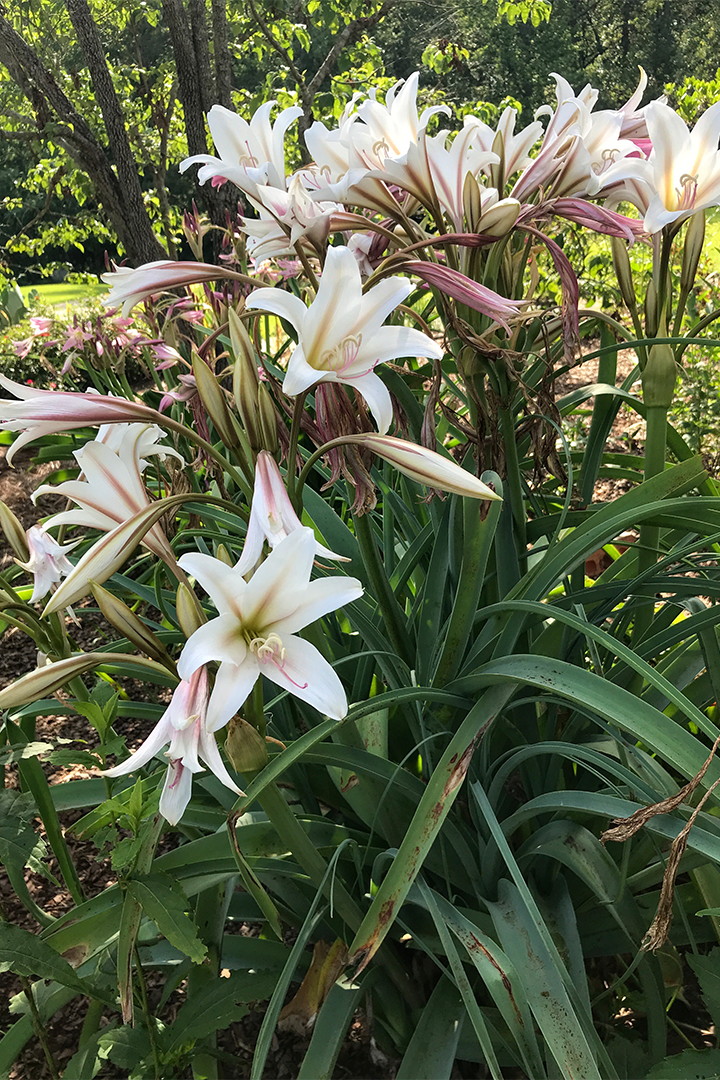
If you’re a plant lover who lives in the Southeast, chances are you’ve heard of crinum lilies and may even have admired them blooming in old cemeteries or abandoned lots. The same chances predict, however, that you’re not growing them. Such is the paradox, even mystery, of these bold, large-flowered, once-you-have-them-they’re-yours-forever bulbs of southern lore. How can such a standout plant have cult status among select gardeners but be missing from so many gardens? I’ve decided it’s time to break the spell and grow more crinums.

Which Crinum Lilies Should You Plant?
I went straight to my friend Frankie Fanelli, southern bulb aficionado, for her top three recommendations for Zone 7 and higher. For a first specimen, she recommends ‘Cecil Houdyshel’ crinum (Crinum ‘Cecil Houdyshel’, Zones 7–11) for its lightly fragrant, shell-pink trumpet flowers that cut an elegant, slightly curving profile. Bloom spikes can reach 5 feet once established, and they continue in succession from June to October if kept well watered.

‘Album’ swamp lily (Crinum × powellii ‘Album’, Zones 7–10) bears pristine white, lily-shape trumpet flowers on 3-foot scapes with a light, sweet fragrance from June to August. One of the parents to both of these crinums is the cape lily (Crinum bulbispermum, Zones 7–10), which starts to bloom in late April in Zone 7b. This beauty holds spicy-scented, white to pink (depending on selection) open-trumpet flowers on 3-foot scapes over blue-green foliage.
Crinums are referred to as lilies, but they are actually in the Amaryllis family and are cousins to daffodils (Narcissus spp. and cvs., Zones 3–8), amaryllis (Hippeastrum spp. and cvs., Zones 8–10), and resurrection lilies (Lycoris squamigera, Zones 5–9). Out of the near 180 species worldwide, a handful of these and many hybrids thrive in southern gardens. Like all amaryllids, they contain poisons that keep herbivores away, no doubt part of the secret to their longevity. Texas horticulturist William Welch infamously summed up their staying power in his book Heirloom Gardening in the South with the assertion that “no crinum has ever died.” Selections vary in cold hardiness and size, but all have long, thick, strappy leaves and tend to form large clumps that resent disturbance. They bloom on tall scapes in bodacious clusters of trumpet-shape or spidery flowers that range from white through all shades of pink. Most are sweetly fragrant, and all are spectacular as cut flowers.

Tips for Planting Crinum Lilies
Prime planting season is spring, but they can even be planted in summer, as they maintain active roots year round. Because of this lack of true dormancy, they are sold potted or through the mail wrapped in sphagnum. For maximum flowering, crinum lilies need good sun (afternoon shade is fine) and even moisture with adequate drainage. Yet they are quite drought tolerant, delaying flowering until rains return. Smaller selections can be grown in containers if space in your garden is at a premium.
Feeling the call of crinum lilies?
As pass-along plants, the time-honored method of acquiring them is to be gifted a few bulbs. These tend to come nameless, ferried in a trash bag, and with the instruction to “plant them where you’re sure you want them, and give them space.” Luckily, there are crinum-adoring nurserymen who have carefully tested and selected the best of the best and offer properly identified bulbs and great advice. Pay attention to hardiness ratings when choosing, but know that extra mulch in winter paired with good drainage may extend root hardiness by at least a half-zone. You’ll find a gracious plenty at southernbulbs.com, jenksfarmer.com, plantdelights.com, nurcar.com, and brentandbeckysbulbs.com. And for those of you who are already growing crinums, thanks for sharing your bulbs!
Paula Gross is the former Assistant Director of the University of North Carolina at Charlotte Botanical Gardens.


















Comments
Log in or create an account to post a comment.
Sign up Log in